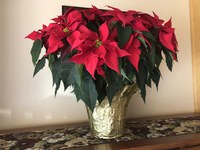Dakota Gardener: The Poinsettia is a Distinctly American Tale of Innovation
(Click an image below to view a high-resolution image that can be downloaded)
By Esther E. McGinnis, Horticulturist
NDSU Extension
Poinsettias are a familiar sight at Christmas. While the plant originated in Central America, the modern history of the poinsettia has a distinctly American flare.
Despite deep cultural and religious roots in Mexico, the plant was largely viewed as a weed in the United States until the 20th century. The journey to adopting the poinsettia as an American Christmas symbol begins with a story of innovative immigrants.
In Germany in the late 1800s, Albert and Henrietta Ecke founded a health spa that served vegetarian meals. As you can imagine, the vegetarian lifestyle was not widely embraced in the land of pork schnitzel.
Seeking a more hospitable business locale, the Ecke family embarked on a voyage in 1902 to start a health spa in tropical Fiji. In route to the South Pacific, the Eckes stopped in Los Angeles and fell in love with the climate and the American dream. To support themselves in California, the family started a dairy, grew fruits and cultivated cut flowers.
At the time, poinsettias grew wild in the Hollywood hills. In its natural state, poinsettias are a scraggly large shrub reaching 10 feet tall. Despite its appearance, Albert saw potential in this red and green plant because of its holiday bloom time. The family began to sell cut poinsettia stems at flower stands on Sunset Boulevard.
When Albert’s son, Paul Ecke Sr., took over the business in 1919, he was concerned about the expanding movie industry. The savvy businessman pivoted the family business to growing flowers near San Diego.
As a horticulturist, Paul sought to transform the poinsettia from a fragile cut flower to a long-lasting potted plant. Through breeding and a top-secret technology, he turned this undistinguished, leggy shrub into a handsome, well-branched potted plant. Competitors could not compete with this product and the Ecke family dynasty was secure.
Paul Ecke Jr. took over the business in 1963 and used his unique talents to cement the family’s status as poinsettia royalty. He designed an ingenious marketing campaign to position the poinsettia as the nation’s Christmas flower.
During the holidays, the Eckes gifted large numbers of poinsettia plants to the White House and to television shows such as The Tonight Show, Bob Hope’s Christmas Special and Good Morning America. Additional plants were sent to women’s magazines. Before long, the colorful plants became a ubiquitous backdrop for talk shows, holiday programs and magazine shoots.
Without having to pay for advertising, poinsettias became linked with the American holiday season. Consequently, the Eckes came to dominate 90% of the market.
All good things, including family dynasties, must come to an end. A series of scientists began to investigate the family secret for producing superior poinsettia plants. By the mid-1990s, they discovered that a plant disease organism, a phytoplasma, was responsible for the beautiful branching and shape of Ecke poinsettias. The Eckes used grafting to infect plants to promote branching and to corner the market for decades.
With its secret unveiled by curious scientists, the Ecke monopoly crumbled. However, all is not lost. The Ecke legacy continues to shine in the poinsettias that brighten our homes.
NDSU Agriculture Communication – Dec. 7, 2021
Source: Esther McGinnis, 701-231-7971, esther.mcginnis@ndsu.edu
Editor: Kelli Anderson, 701-231-6136, kelli.c.anderson@ndsu.edu




